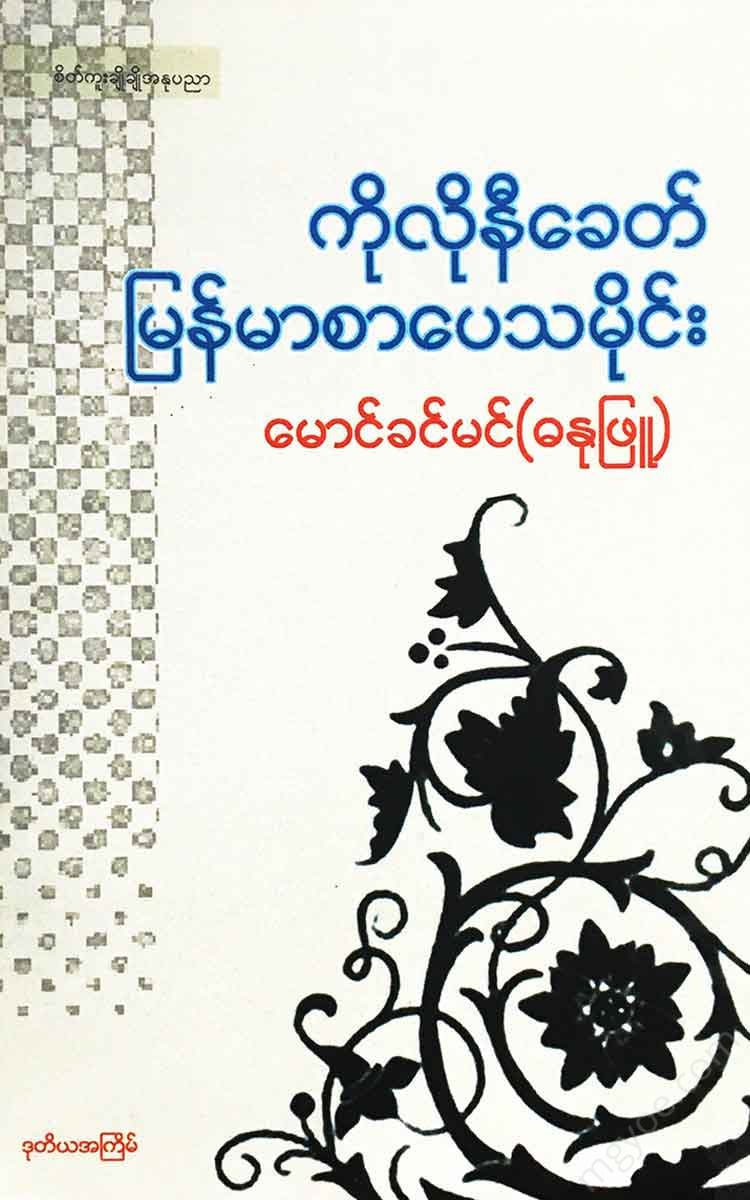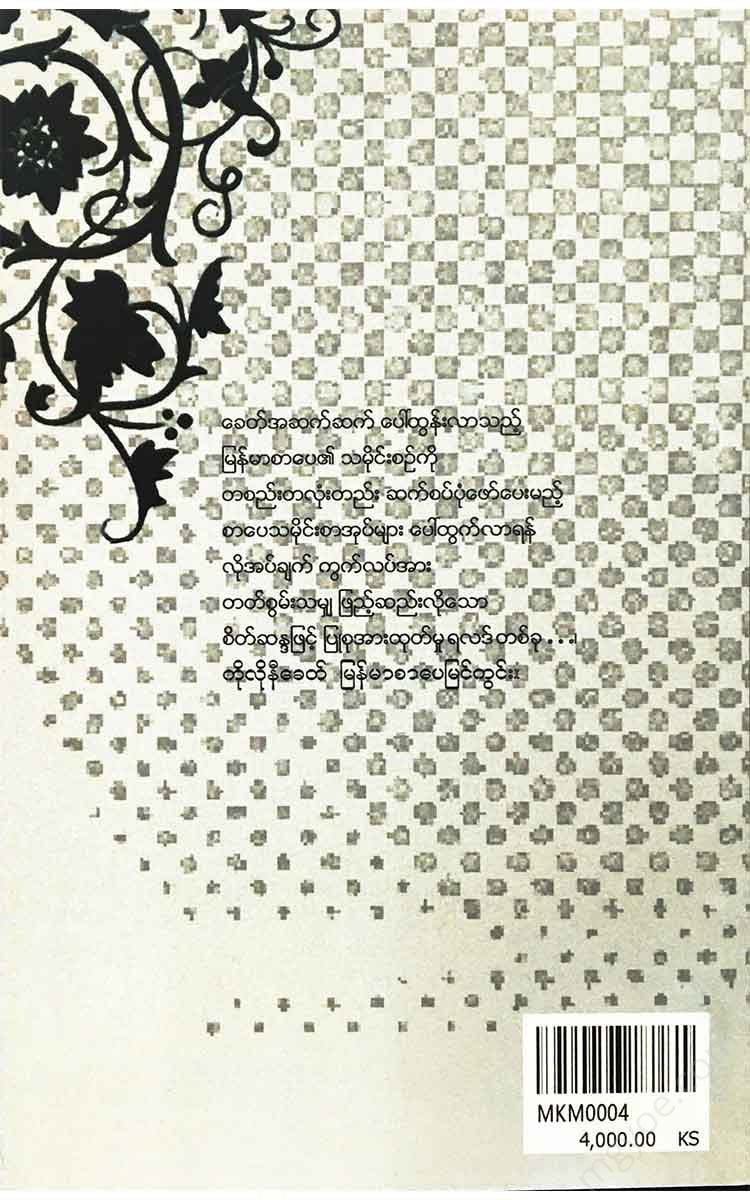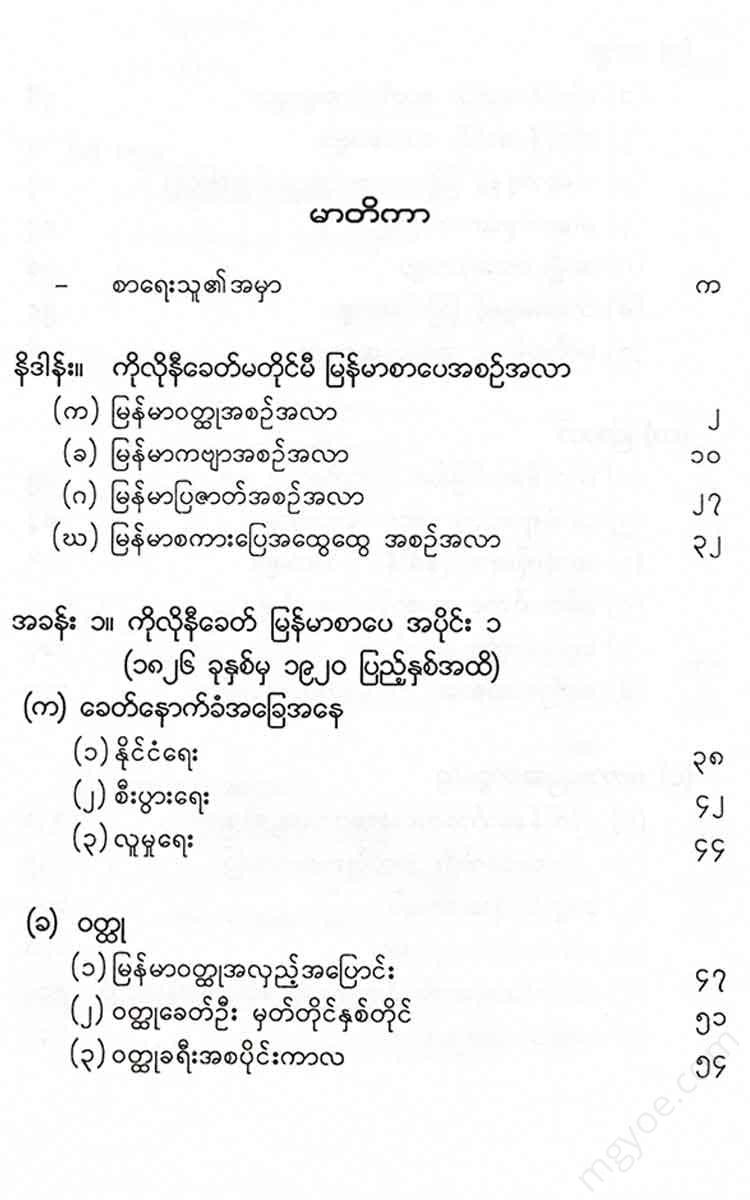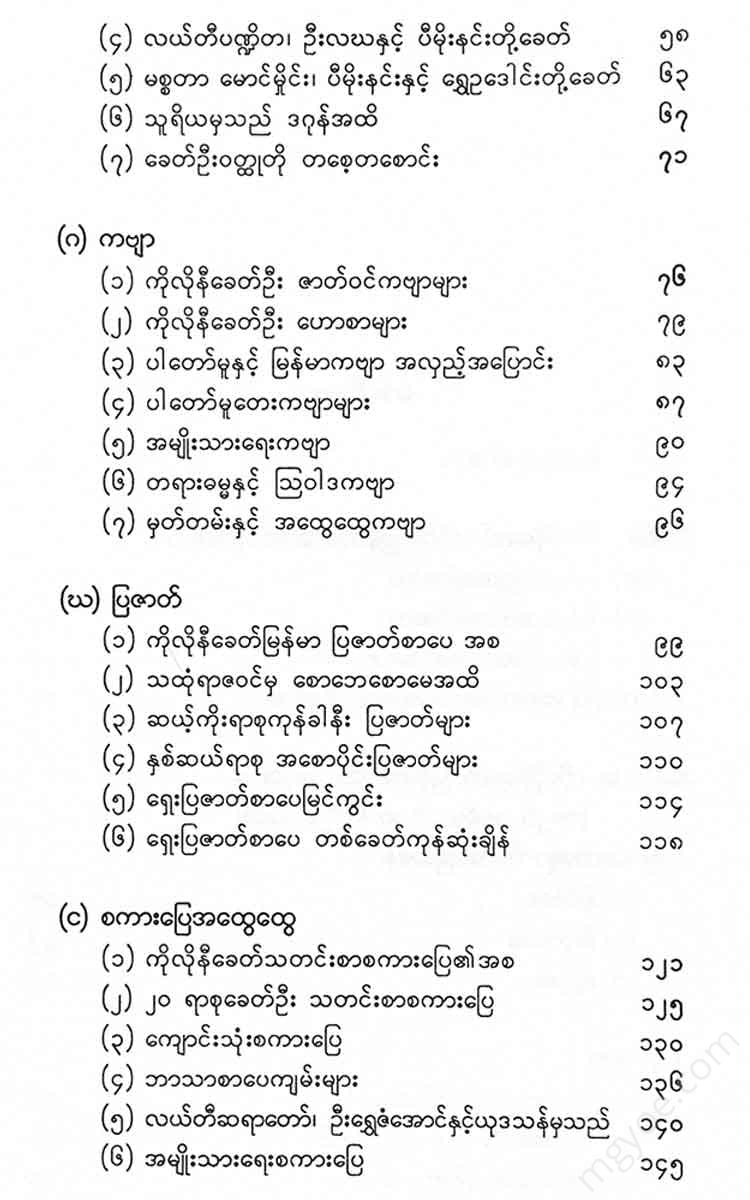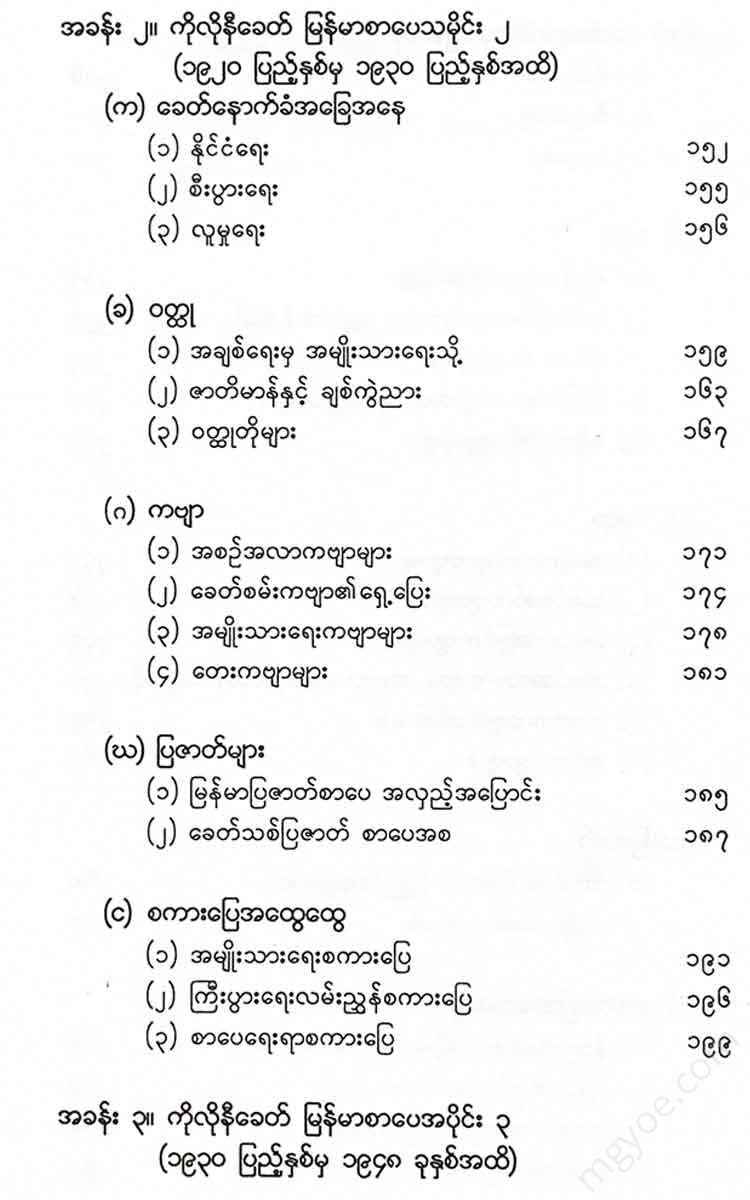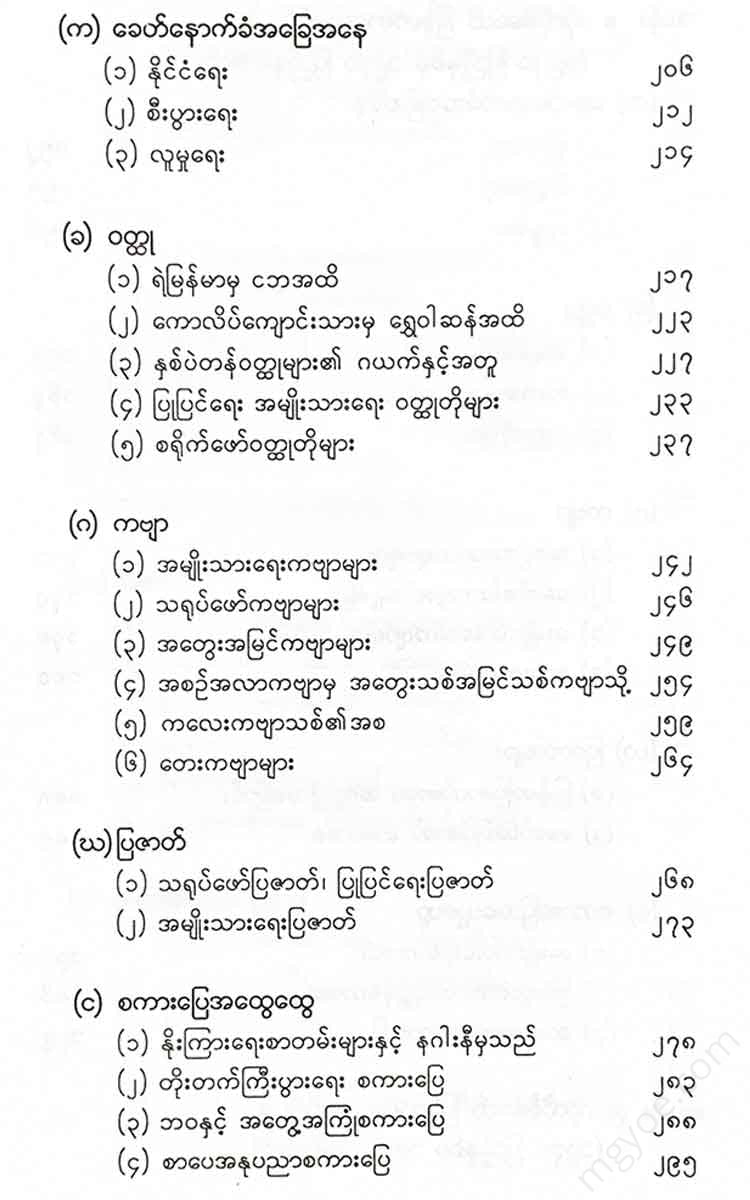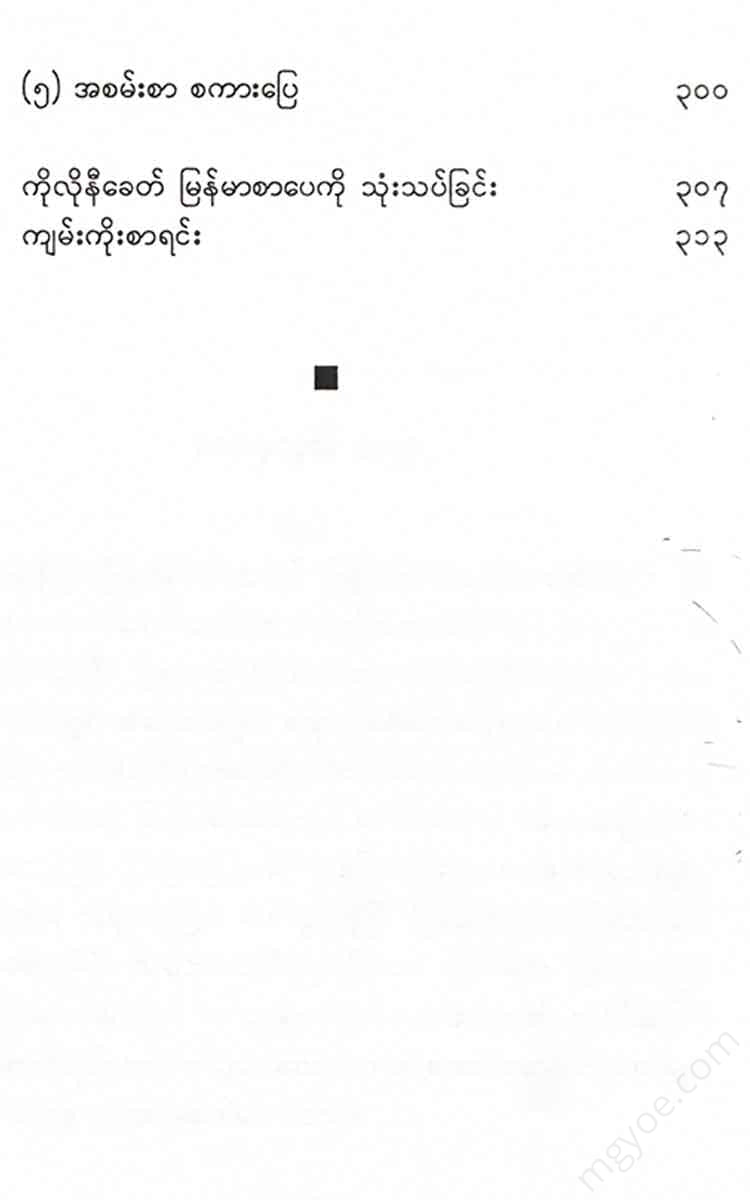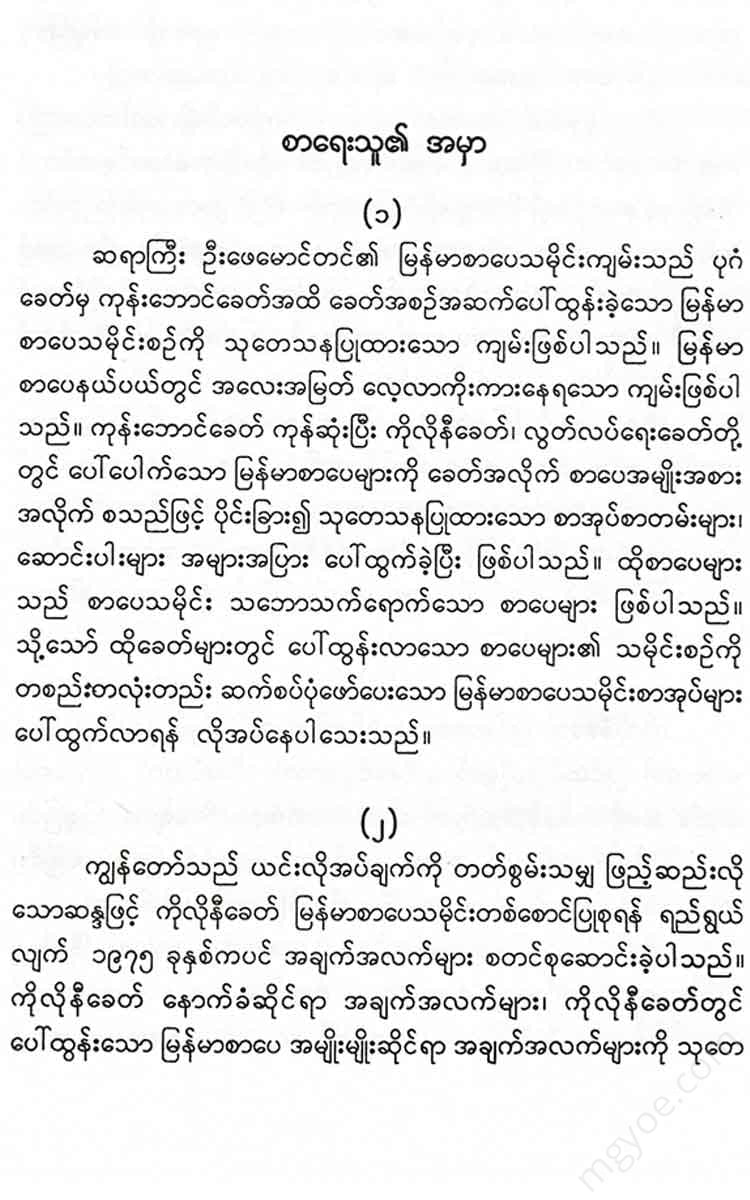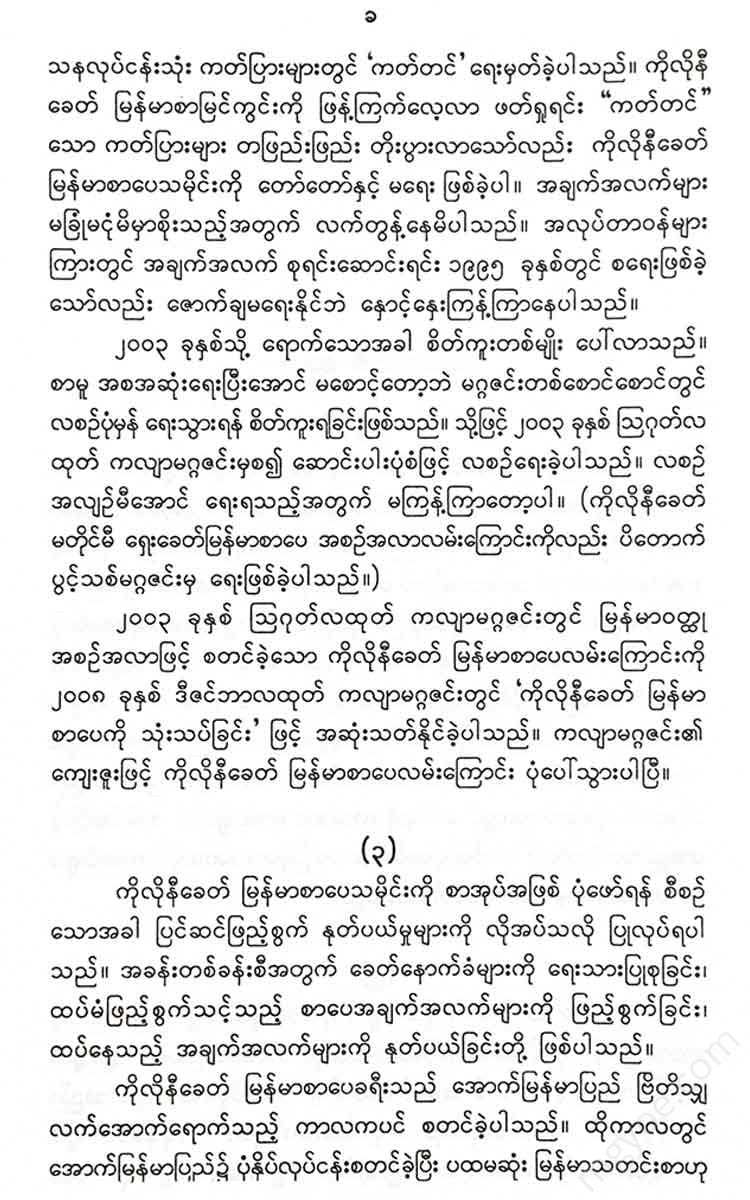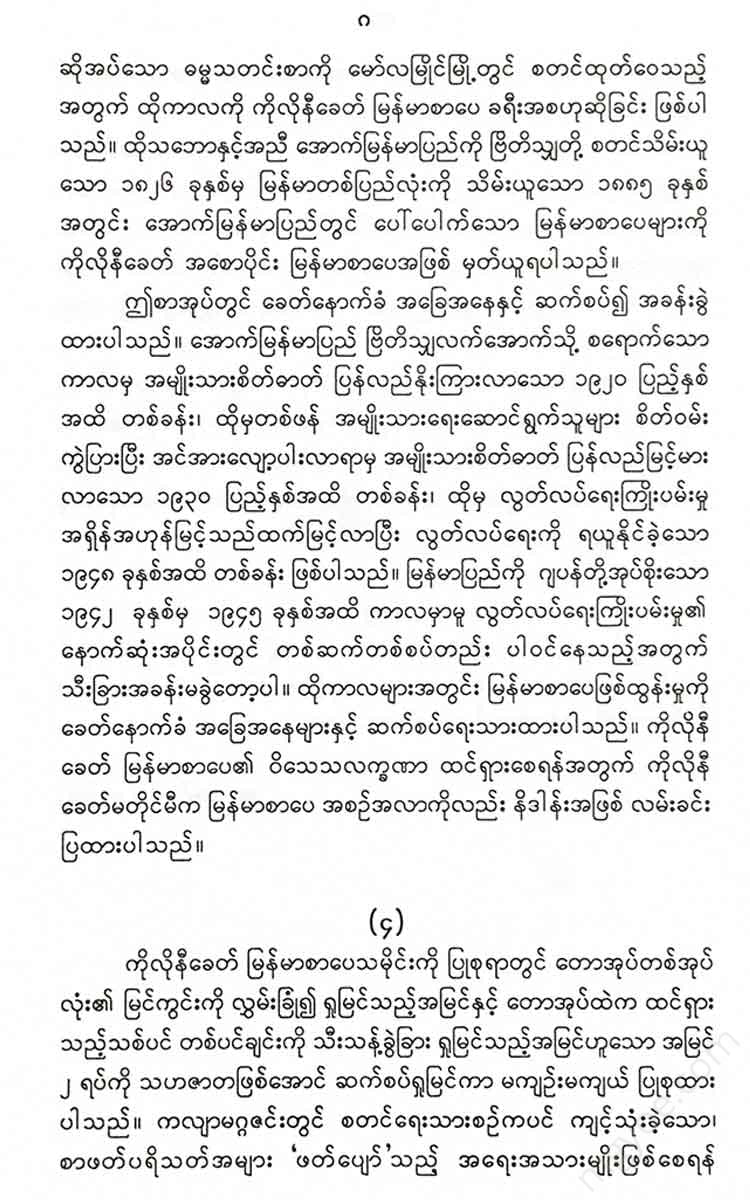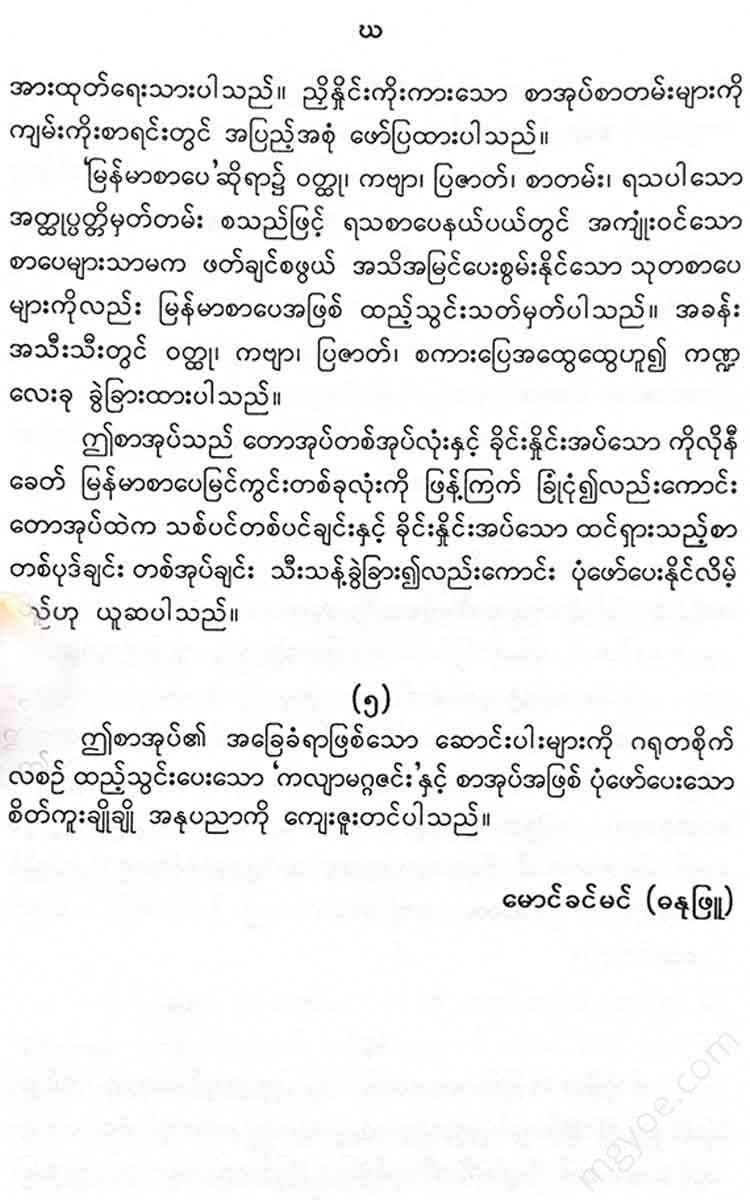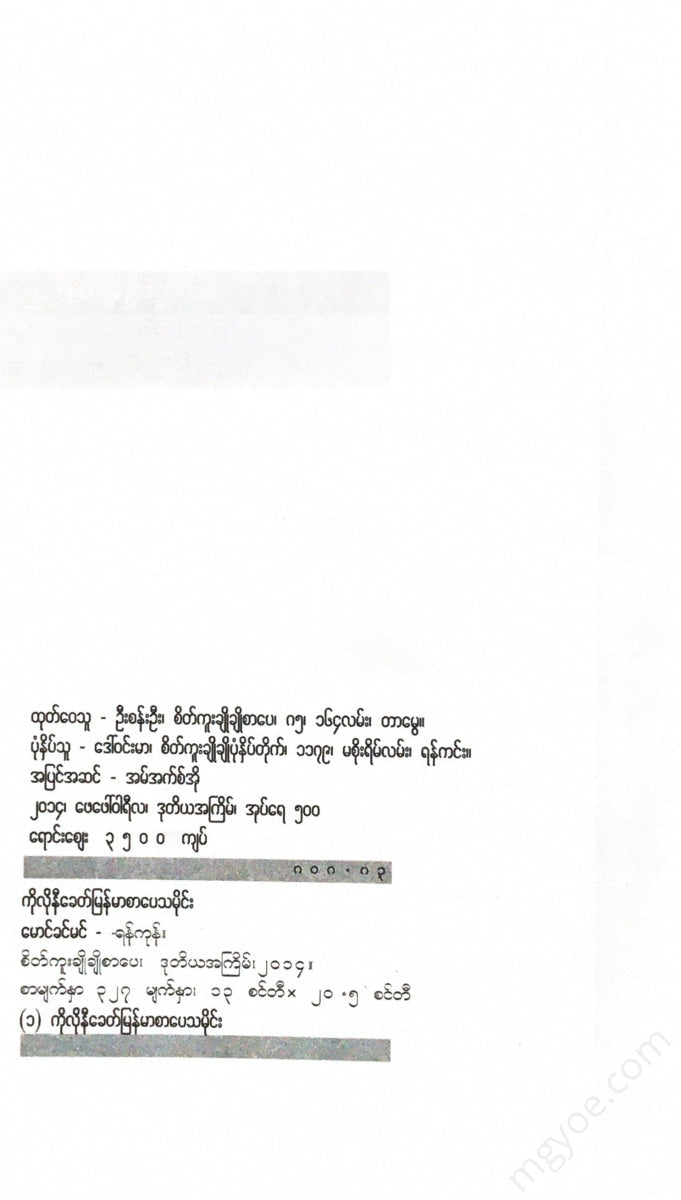စိတ်ကူးချိုချိုစာပေ
Maung Khin Min (Dhanuphu) - History of Burmese Literature in the Colonial Period
Maung Khin Min (Dhanuphu) - History of Burmese Literature in the Colonial Period
Couldn't load pickup availability
Some say, “It was only after the first novel, “Maung Yin Maung Ma Mae Ma,” appeared in the early twentieth century that Burmese people began to understand the meaning of literature. Before that time, Burmese people did not understand the meaning of literature.” This claim dismisses the role of the novel, which has appeared throughout the history of Burmese literature, in the form of a story, and a Buddhist novel.
Some say, “There have been Buddhist novels throughout the history of Burmese literature. The contemporary novels that emerged during the colonial era are no more unique than the existing novels.” This argument also dismisses the role of the newly emerging contemporary novels.
Based on these two statements, if we were to make a balanced analysis, we could conclude that “the Burmese novel emerged through the contact between the strong Buddhist literary tradition of Myanmar and the “novel” novel concepts and methods that flourished in the West.” To clarify this analysis, I would like to first trace the Burmese novel tradition.
If we are to describe the Burmese literary tradition, we must start with the story. Scholars say that traditional stories have been emerging among various nations even before the advent of writing. Stories emerged when ancient people recounted their experiences, added creative ideas, and composed them to make the listeners interested. The events, stories, and characters included in the stories are the basic concepts of the story. Therefore, it can be said that the tradition of Burmese literature has been developing as “oral literature” even before the advent of Burmese writing.
After the arrival of Theravada Buddhism in Myanmar in the eleventh century, when the Burmese studied Buddhist literature, the basic concepts of the Vedas became more powerful. Various types of Buddhist literature and Vedas are found as ancient evidence in the form of clay pots, enamel rings, stone carvings, and wall paintings. For example, the “Temimin Alosankhan” clay pot excavated from Hmaozhar Khinba Kone, and other Buddhist-themed clay pots found throughout Myanmar, the jade rings depicting the life stories from the Ananda Cave Pagoda in Bagan, the murals depicting the life stories and the Mahavina stories from the Myingapa Gupyakgyi Pagoda, the murals depicting the Mahanipat (ten great stories) from the Lokayekpan Cave Pagoda, and the murals depicting the life stories and the Vimana stories from the Vinayakdho Cave Pagoda are prominent examples. The illustrations are usually written in Pali and Mon, and when Burmese writing emerged, inscriptions in Burmese also appeared.
The inscription of Min Ananta (four-sided) states that “five hundred Jatakas are also beautifully written”, indicating that the practice of painting Jatakas on the walls of pagodas during the Bagan period was widespread. According to the evidence mentioned, the Bagan people were already familiar with Buddhist literature such as the Jataka, Buddhavan, Patevuthu, and Vimana Nawat. In the inscription of the Wet Gyi Inn Tak Nue Monastery, which was inscribed in the old city of Bagan in the year 804 (1442 AD) after the fall of Bagan, the Taungdwin King Zeyathura and his wife wrote a list of books donated by the name of “Five Hundred and Fifty Nissays”, “Jatka Ghin Nissays”, “Dhammapada Gandhi Nissays” along with other Nissays are found. According to this evidence, after the fall of Bagan, the Jataka, It is clear that the Dhamma books continue to spread.
Throughout the Bagan period, the Burmese, who had become familiar with Buddhist literature, began to translate these works, which were originally in Pali, into Burmese, in prose and poetry, when they reached the Inva period. Buddhist literature, which was only at the level of pictorial illustrations in the Bagan period, appeared extensively in the form of letters and poems in the Inva period. One interesting fact is that Buddhist literature is found not only in the form of “prose works” but also in the form of “poetry works”. The Mahasila Vamsa wrote a novel called “Parayana Vutthu” about eight exemplary figures of the Buddha’s time, such as Sariputta and Moggallana, and is considered to be the first Buddhist prose novel to appear. In that novel, the character development, which is a basic feature of the Vutthu, is clearly seen. In the novel of Sariputta, the events of Sariputta's life from his birth to his passing away are not written "longitudinal" but rather, Sariputta's wise character, his love for the wise, his unyielding character, his support for his companions, and his humility are depicted "in a linear fashion" one by one.
During the Inva period, long four-line poems called “poetry” emerged. Most of the poetry were re-written in the form of poems from the Jataka and Buddhist stories. They can be called “poetry novels.” The first poetry to appear was the Buridat Jataka of the Maharastra. It was a cover of the Mahanipat Buridat Jataka. What is remarkable is that no work of land surveying and composition was found before that poetry, and a high-level poetry like the Buridat Jataka appeared. It is said that at that time, Jataka and poems like poetry flourished in Ceylon. It is known that one of the teachers who studied with Maharastra was a monk from Ceylon (Sisitha). The monk came across the Jātaka poems while in Ceylon and told his disciple, Maharatthasara, about them. Maharatthasara got the idea to compose Jātaka poems, and Dr. Hla Be has noted that it is possible that he composed Jātaka poems.
The Maharatthasara, the Mahasilawansa, the Aggasamadhi, the Tejasara, and the Omnyo were all poets of the Inva period. The poets originally composed the stories of the epics to make them more vivid, the characters more alive, and the time and place more vivid, adding their own creative elements to them. The stories, characters, and backgrounds of these novels, which originated in India in the Pali language, were brought to life by the skill of the Burmese poets and became Burmese in form. Thus, in the Burmese epic of the Burmese epic of the Burmese epic, when the Naga king Burmese king returned from the clutches of the Alammay, the Naga audience who came to ask for news became a Burmese audience who supported and supported each other. From the Paramitaw Khan of the Mahasila Vamsa, Sumedha the Hermit became a Burmese Hermit. From the Naimy Bon Khan of the Aggasamadhi Maung Khin Min (Dhanuphu), the period when King Naimy was taken to the heavenly realm by the Matali Nattsaran became the Kason month in Myanmar, which was filled with the fragrance of the earth. From the Thanvara of the Maharatthasarah, Varanasi became the capital of the Burmese King Nay Pyi Taw, which was beautiful with its day and night views. These creations reflect the principles of literary knowledge and methods. Since the tradition of recreating the existing traditional works was strong at that time, it can be said that the poets of the Poth added their own creations within the framework of that tradition. If a tradition of creating from scratch with their own ideas had emerged, the poets of that time would have created their own stories, characters, It is possible that they wrote prose and poetry based on this background. On the other hand, one wonders if the poets of that time were monks and therefore did not write secular works.
The tradition of novels that was firmly established in the Inva period continued to flourish throughout the history of Burmese literature until the end of the Konbaung period. In the prose genre, novels based on the Jataka, the Buddha's life, and the Dhammapada appeared. In the Nyaungran period, the Manikundala novel by Varabi Sangha Nath Sayadaw took the Maha Sutta Soma Jataka of the 550th Nipatla era as its foundation and incorporated almost all the remaining Jatakas of the 550th Nipatla era, so it is surprising that all the Jataka novels have become intertwined like a network. The Yasavakunavuthu of Taungphila Sayadaw and the Yadanakara novel by Saddhamma Linkara Sayadaw are elegant and elegant prose novels. In the Konbaung period, novels based on the Buddha's life and Jataka novels continued to appear. Among the Buddhist novels, the most notable are the Udana Dipani, a history of Burmese literature during the colonial era, by the Depayin Sayadaw, the Maha Buddha Vin Nabhatay by the First Phekhun Sayadaw, the Mala Linkara Nabhatay by the Second Mae Hti Sayadaw, and the Jinatha Pakathani by the Kyaithe Laythat Sayadaw. Nyaungkan Sayadaw directly translated the five hundred and fifty Nipa novels into Burmese. U Obasa, Shin Sanya Tikhka and Shin Nanda Medha translated the ten Jatka novels into Burmese. In particular, U Sobasa's excellent writing style makes the story, characters, and background come together in the Vaisantara Jatkay. The ten Jatka novels do not include the author's own creative ideas as in the Pooja novels. The information is rewritten from the Pali Jatkathas in their original form. However, the use of ornate prose pieces makes it more lively and interesting to read. The Saddansinmin Vutthug testifies to the fact that U Punya's use of ornate Buddhist literature to create sermons that would appeal to the audience became more lively and more realistic.
From a poetic perspective, works that rewrote Buddhist literature into poems appeared at a rapid pace until the end of the Konbaung period. Famous poets of poems such as King Dwinthin, Mongyul Sayadaw, and U Shun elaborated the poems into great poems that were worth reading. King Aung Daw's Mahajanaka Poo depicts the zeal of King Aung Daw, King Kusa's love and strength from Mongyul Sayadaw's Kusada Poo, and King Siwi's longing and regret from U Shun's Ummadanti Poo are good scenes that bring these characters to life.
Folktales are the origin of the long novel, as well as the short story. Starting with the story of the "Golden Rabbit and the Golden Tiger," the stories that have been told over the generations include short, concise stories.
